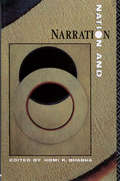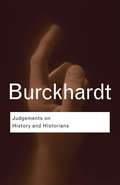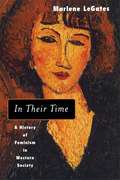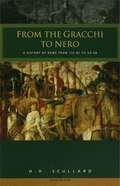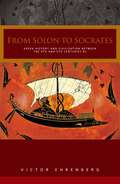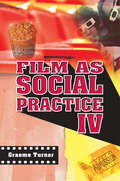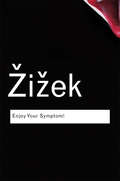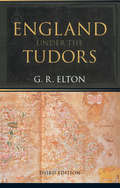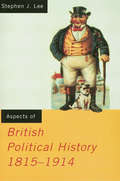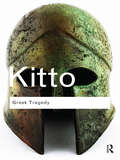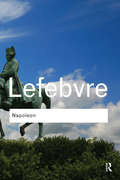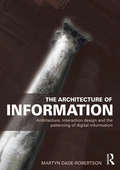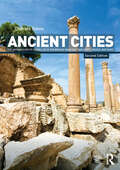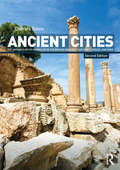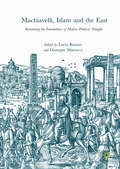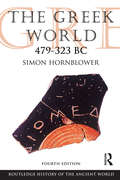- Table View
- List View
Nation and Narration
by K. Homi BhabhaBhabha, in his preface, writes 'Nations, like narratives, lose their origins in the myths of time and only fully encounter their horizons in the mind's eye'.From this seemingly impossibly metaphorical beginning, this volume confronts the realities of the concept of nationhood as it is lived and the profound ambivalence of language as it is written. From Gillian Beer's reading of Virginia Woolf, Rachel Bowlby's cultural history of Uncle Tom's Cabin and Francis Mulhern's study of Leaviste's 'English ethics'; to Doris Sommer's study of the 'magical realism' of Latin American fiction and Sneja Gunew's analysis of Australian writing, Nation and Narration is a celebration of the fact that English is no longer an English national consciousness, which is not nationalist, but is the only thing that will give us an international dimension.
Nation and Narration (PDF)
by Homi K BhabhaBhabha, in his preface, writes 'Nations, like narratives, lose their origins in the myths of time and only fully encounter their horizons in the mind's eye'.From this seemingly impossibly metaphorical beginning, this volume confronts the realities of the concept of nationhood as it is lived and the profound ambivalence of language as it is written. From Gillian Beer's reading of Virginia Woolf, Rachel Bowlby's cultural history of Uncle Tom's Cabin and Francis Mulhern's study of Leaviste's 'English ethics'; to Doris Sommer's study of the 'magical realism' of Latin American fiction and Sneja Gunew's analysis of Australian writing, Nation and Narration is a celebration of the fact that English is no longer an English national consciousness, which is not nationalist, but is the only thing that will give us an international dimension. 9780415014830
Judgements on History and Historians
by Jacob BurckhardtWestern Civilisation was in its pomp when Jacob Burckhardt delivered his Judgements on History and Historians; European Empires spanned the globe, while the modern age was being forged in the nationalist revolutions of 1848. As a tutor to the young Friedrich Nietzsche as well as one of the first historians to take 'culture' as his subject rather than the triumphs and travails of kings and generals, Burckhardt was at the vanguard of this modern sensibility. Ambitious in its scope, ranging from the days of Ancient Egypt, through the Reformation to the time of Napoleon, this is indeed a history of 'Western Civilization', written before two monstrous world wars threw such a concept into disrepute.
In Their Time: A History of Feminism in Western Society
by Marlene LeGatesMarlene LeGates has written a thorough, lively and accessible overview of Western feminist movements from the Middle Ages through the latter twentieth century. With each chapter containing a timeline and brief excerpts from primary source documents, the text serve as an ideal basis for a history of feminism or women's studies course, or as a supplementary text in a broader women's history or western civilization course.
In Their Time: A History of Feminism in Western Society
by Marlene LeGatesMarlene LeGates has written a thorough, lively and accessible overview of Western feminist movements from the Middle Ages through the latter twentieth century. With each chapter containing a timeline and brief excerpts from primary source documents, the text serve as an ideal basis for a history of feminism or women's studies course, or as a supplementary text in a broader women's history or western civilization course.
From the Gracchi to Nero: A History of Rome 133 BC to AD 68
by H. H. ScullardScullard's clear and comprehensive narrative covers the period from 133 BC to 69 AD, exploring the decline and fall of the Republic, and the establishment of the Pax Romana under the early Principate. More than forty years after its first publication this masterful survey remains the standard textbook on the central period of Roman history.
From the Gracchi to Nero: A History of Rome 133 BC to AD 68
by H. H. ScullardScullard's clear and comprehensive narrative covers the period from 133 BC to 69 AD, exploring the decline and fall of the Republic, and the establishment of the Pax Romana under the early Principate. More than forty years after its first publication this masterful survey remains the standard textbook on the central period of Roman history.
From Solon to Socrates: Greek History and Civilization During the 6th and 5th Centuries BC
by V. EhrenbergFirst published in 1973. Routledge is an imprint of Taylor & Francis, an informa company.
From Solon to Socrates: Greek History and Civilization During the 6th and 5th Centuries BC
by V. EhrenbergFirst published in 1973. Routledge is an imprint of Taylor & Francis, an informa company.
Film as Social Practice
by Graeme TurnerThis fourth edition of our bestselling text has been comprehensively updated and revised to include contemporary film analysis and recent films. With a focus on contemporary popular cinema and examples from Classical Hollywood, Graeme Turner examines the social and cultural aspects of film from audiences and ideologies to exhibition and technology. This fourth edition now includes: new sections dealing with debates about spectacle and special effects an extended treatment of sound and its contribution to cinema film theory’s discussion of the representation of race and ethnicity a thorough update of individual film references a revised applications chapter that includes new contemporary examples new illustrations from contemporary popular cinema. Students of film studies, film practice and film theory will find this a welcome addition to their degree course studies.
Enjoy Your Symptom!: Jacques Lacan in Hollywood and Out
by Slavoj ZizekThe title is just the first of many startling asides, observations and insights that fill this guide to Hollywood on the Lacanian psychoanalyst’s couch. Zizek introduces the ideas of Jacques Lacan through the medium of American film, taking his examples from over 100 years of cinema, from Charlie Chaplin to The Matrix and referencing along the way such figures as Lenin and Hegel, Michel Foucault and Jesus Christ. Enjoy Your Symptom! is a thrilling guide to cinema and psychoanalysis from a thinker who is perhaps the last standing giant of cultural theory in the twenty-first century.
Enjoy Your Symptom!: Jacques Lacan in Hollywood and Out
by Slavoj ZizekThe title is just the first of many startling asides, observations and insights that fill this guide to Hollywood on the Lacanian psychoanalyst’s couch. Zizek introduces the ideas of Jacques Lacan through the medium of American film, taking his examples from over 100 years of cinema, from Charlie Chaplin to The Matrix and referencing along the way such figures as Lenin and Hegel, Michel Foucault and Jesus Christ. Enjoy Your Symptom! is a thrilling guide to cinema and psychoanalysis from a thinker who is perhaps the last standing giant of cultural theory in the twenty-first century.
England Under the Tudors
by G. R. EltonFirst published in 1955 and never out of print, this wonderfully written text by one of the great historians of the twentieth century has guided generations of students through the turbulent history of Tudor England. Now in its third edition, England Under the Tudors charts a historical period that saw some monumental changes in religion, monarchy, government and the arts. Elton's classic and highly readable introduction to the Tudor period offers an essential source of information from the start of Henry VII's reign to the death of Elizabeth I.
England Under the Tudors
by G. R. EltonFirst published in 1955 and never out of print, this wonderfully written text by one of the great historians of the twentieth century has guided generations of students through the turbulent history of Tudor England. Now in its third edition, England Under the Tudors charts a historical period that saw some monumental changes in religion, monarchy, government and the arts. Elton's classic and highly readable introduction to the Tudor period offers an essential source of information from the start of Henry VII's reign to the death of Elizabeth I.
Aspects of British Political History 1815-1914
by Stephen J. LeeAspects of British History, 1815-1914 addresses the major issues of this much-studied period in a clear and digestible form.* Introduces a fresh feel to long-studied topics* Consolidates a grest deal of recent research* Carefully organised to reflect the way teachers tackle this course* Written by and experienced and renowned textbook author* Illustrated with helpful maps and photographs
Aspects of British Political History 1815-1914
by Stephen J. LeeAspects of British History, 1815-1914 addresses the major issues of this much-studied period in a clear and digestible form.* Introduces a fresh feel to long-studied topics* Consolidates a grest deal of recent research* Carefully organised to reflect the way teachers tackle this course* Written by and experienced and renowned textbook author* Illustrated with helpful maps and photographs
Greek Tragedy (Routledge Classics)
by H.D.F. Kitto'Two things give Kitto's classic book its enduring freshness: he pioneered the approach to Greek drama through internal artistry and thematic form, and he always wrote in lively and readable English.' - Oliver Taplin, University of Oxford, UK Why did Aeschylus characterize differently from Sophocles? Why did Sophocles introduce the third actor? Why did Euripides not make better plots? So asks H.D.F Kitto in his acclaimed study of Greek tragedy, available for the first time in Routledge Classics. Kitto argues that in spite of dealing with big moral and intellectual questions, the Greek dramatist is above all an artist and the key to understanding classical Greek drama is to try and understand the tragic conception of each play. In Kitto’s words ‘We shall ask what the dramatist is striving to say, not what in fact he does say about this or that.’ Through a brilliant analysis of Aeschylus’s ‘Oresteia’, the plays of Sophocles including ‘Antigone’ and ‘Oedipus Tyrannus’; and Euripides’s ‘Medea’ and ‘Hecuba’, Kitto skilfully conveys the enduring artistic and literary brilliance of the Greek dramatists. H.D.F Kitto (1897 – 1982) was a renowned British classical scholar. He lectured at the University of Glasgow from 1920-1944 before becoming Professor of Greek at Bristol University, where he taught until 1962.
Napoleon (Routledge Classics)
by Georges LefebvreWith a new introduction by Andrew Roberts. 'A penetrating interpretation...No one with a serious interest in the Napoleonic period can afford to ignore it. ' - Times Literary Supplement Whether viewed as an inspired leader or obsessed tyrant, Napoleon has divided opinion for over 200 years. Few individuals have left such a mark on history. Georges Lefebvre's classic work, published in Routledge Classics in one paperback volume in English for the first time, is a definitive portrait of the Napoleonic era. Lefebvre’s history sweeps us from the lightning coup d’état of 18 Brumaire in 1799 to his final downfall amidst the wheatfields of Waterloo. More than a biography, it is a brilliant survey of the turbulent age Napoleon inaugurated in his attempt to redraw the map of Europe, from the Peninsular War to the invasion of Russia. The cast includes his antagonists – Pitt the Younger, Wellington, Metternich and Tsar Alexander – and his allies – the wily Minister of Police Fouché and Talleyrand, the ‘Prince of Diplomats’. Lefebvre’s account is equally clear-eyed about Napoleon’s genius and his flaws. Napoleon’s determination to emulate Caesar and Augustus condemned Europe to more than a decade of war and economic crisis, but he also built an empire, introducing educational, administrative and financial initiatives that are still in place today. Georges Lefebvre (1877-1959) One of the foremost historians of the Twentieth Century and known as the ‘historian’s historian’, he held the chair of the French Revolution at the Sorbonne . His The French Revolution is also available in Routledge Classics.
The Architecture of Information: Architecture, Interaction Design and the Patterning of Digital Information
by Martyn Dade-RobertsonThis book looks at relationships between the organization of physical objects in space and the organization of ideas. Historical, philosophical, psychological and architectural knowledge are united to develop an understanding of the relationship between information and its representation. Despite its potential to break the mould, digital information has relied on metaphors from a pre-digital era. In particular, architectural ideas have pervaded discussions of digital information, from the urbanization of cyberspace in science fiction, through to the adoption of spatial visualizations in the design of graphical user interfaces. This book tackles: the historical importance of physical places to the organization and expression of knowledge the limitations of using the physical organization of objects as the basis for systems of categorization and taxonomy the emergence of digital technologies and the twentieth century new conceptual understandings of knowledge and its organization the concept of disconnecting storage of information objects from their presentation and retrieval ideas surrounding ‘semantic space’ the realities of the types of user interface which now dominate modern computing.
The Architecture of Information: Architecture, Interaction Design and the Patterning of Digital Information
by Martyn Dade-RobertsonThis book looks at relationships between the organization of physical objects in space and the organization of ideas. Historical, philosophical, psychological and architectural knowledge are united to develop an understanding of the relationship between information and its representation. Despite its potential to break the mould, digital information has relied on metaphors from a pre-digital era. In particular, architectural ideas have pervaded discussions of digital information, from the urbanization of cyberspace in science fiction, through to the adoption of spatial visualizations in the design of graphical user interfaces. This book tackles: the historical importance of physical places to the organization and expression of knowledge the limitations of using the physical organization of objects as the basis for systems of categorization and taxonomy the emergence of digital technologies and the twentieth century new conceptual understandings of knowledge and its organization the concept of disconnecting storage of information objects from their presentation and retrieval ideas surrounding ‘semantic space’ the realities of the types of user interface which now dominate modern computing.
Ancient Cities: The Archaeology of Urban Life in the Ancient Near East and Egypt, Greece and Rome
by Charles GatesAncient Cities surveys the cities of the Ancient Near East, Egypt, and the Greek and Roman worlds from the perspectives of archaeology and architectural history, bringing to life the physical world of ancient city dwellers by concentrating on evidence recovered from archaeological excavations. Urban form is the focus: the physical appearance and overall plans of the cities, their architecture and natural topography, and the cultural and historical contexts in which they flourished. Attention is also paid to non-urban features such as religious sanctuaries and burial grounds, places and institutions that were a familiar part of the city dweller's experience. Objects or artifacts that represented the essential furnishings of everyday life are discussed, such as pottery, sculpture, wall paintings, mosaics and coins. Ancient Cities is unusual in presenting this wide range of Old World cultures in such comprehensive detail, giving equal weight to the Preclassical and Classical periods, and in showing the links between these ancient cultures. User-friendly features include: use of clear and accessible language, assuming no previous background knowledge lavishly illustrated with over 300 line drawings, maps, and photos historical summaries, further reading arranged by topic, plus a consolidated bibliography and comprehensive index new to the second edition: a companion website with an interactive timeline, chapter summaries, study questions, illustrations and a glossary of archaeological and historical terms. Visit the website at http://cw.routledge.com/textbooks/9780415498647/ In this second edition, Charles Gates has comprehensively revised and updated his original text, and Neslihan Y?lmaz has reworked her acclaimed illustrations. Readers and lecturers will be delighted to see a new chapter on Phoenician cities in the first millennium BC, and new sections on Göbekli Tepe, the sensational Neolithic sanctuary; Sinope, a Greek city on the Black Sea coast; and cities of the western Roman Empire. With its comprehensive presentation of ancient Mediterranean and Near Eastern cities, its rich collection of illustrations, and its new companion website, Ancient Cities will remain an essential textbook for university and high school students across a wide range of archaeology, ancient history, and ancient Near Eastern, Biblical, and classical studies courses.
Ancient Cities: The Archaeology of Urban Life in the Ancient Near East and Egypt, Greece and Rome
by Charles GatesAncient Cities surveys the cities of the Ancient Near East, Egypt, and the Greek and Roman worlds from the perspectives of archaeology and architectural history, bringing to life the physical world of ancient city dwellers by concentrating on evidence recovered from archaeological excavations. Urban form is the focus: the physical appearance and overall plans of the cities, their architecture and natural topography, and the cultural and historical contexts in which they flourished. Attention is also paid to non-urban features such as religious sanctuaries and burial grounds, places and institutions that were a familiar part of the city dweller's experience. Objects or artifacts that represented the essential furnishings of everyday life are discussed, such as pottery, sculpture, wall paintings, mosaics and coins. Ancient Cities is unusual in presenting this wide range of Old World cultures in such comprehensive detail, giving equal weight to the Preclassical and Classical periods, and in showing the links between these ancient cultures. User-friendly features include: use of clear and accessible language, assuming no previous background knowledge lavishly illustrated with over 300 line drawings, maps, and photos historical summaries, further reading arranged by topic, plus a consolidated bibliography and comprehensive index new to the second edition: a companion website with an interactive timeline, chapter summaries, study questions, illustrations and a glossary of archaeological and historical terms. Visit the website at http://cw.routledge.com/textbooks/9780415498647/ In this second edition, Charles Gates has comprehensively revised and updated his original text, and Neslihan Y?lmaz has reworked her acclaimed illustrations. Readers and lecturers will be delighted to see a new chapter on Phoenician cities in the first millennium BC, and new sections on Göbekli Tepe, the sensational Neolithic sanctuary; Sinope, a Greek city on the Black Sea coast; and cities of the western Roman Empire. With its comprehensive presentation of ancient Mediterranean and Near Eastern cities, its rich collection of illustrations, and its new companion website, Ancient Cities will remain an essential textbook for university and high school students across a wide range of archaeology, ancient history, and ancient Near Eastern, Biblical, and classical studies courses.
Machiavelli, Islam and the East: Reorienting the Foundations of Modern Political Thought
by Lucio Biasiori Giuseppe MarcocciThis volume provides the first survey of the unexplored connections between Machiavelli’s work and the Islamic world, running from the Arabic roots of The Prince to its first translations into Ottoman Turkish and Arabic. It investigates comparative descriptions of non-European peoples, Renaissance representations of Muḥammad and the Ottoman military discipline, a Jesuit treatise in Persian for a Mughal emperor, peculiar readers from Brazil to India, and the parallel lives of Machiavelli and the bureaucrat Celālzāde Muṣṭafá. Ten distinguished scholars analyse the backgrounds, circulation and reception of Machiavelli’s writings, focusing on many aspects of the mutual exchange of political theories and grammars between East and West. A significant contribution to attempts by current scholarship to challenge any rigid separation within Eurasia, this volume restores a sense of the global spreading of books, ideas and men in the past.
Machiavelli, Islam and the East: Reorienting the Foundations of Modern Political Thought
by Lucio Biasiori Giuseppe MarcocciThis volume provides the first survey of the unexplored connections between Machiavelli’s work and the Islamic world, running from the Arabic roots of The Prince to its first translations into Ottoman Turkish and Arabic. It investigates comparative descriptions of non-European peoples, Renaissance representations of Muḥammad and the Ottoman military discipline, a Jesuit treatise in Persian for a Mughal emperor, peculiar readers from Brazil to India, and the parallel lives of Machiavelli and the bureaucrat Celālzāde Muṣṭafá. Ten distinguished scholars analyse the backgrounds, circulation and reception of Machiavelli’s writings, focusing on many aspects of the mutual exchange of political theories and grammars between East and West. A significant contribution to attempts by current scholarship to challenge any rigid separation within Eurasia, this volume restores a sense of the global spreading of books, ideas and men in the past.
The Greek World 479–323 BC (The Routledge History of the Ancient World)
by Simon HornblowerThe Greek World 479-323 BC has been an indispensable guide to classical Greek history since its first publication nearly thirty years ago. Now Simon Hornblower has comprehensively revised and partly rewritten his original text, bringing it up-to-date for yet another generation of readers. In particular, this fourth edition takes full account of recent and detailed scholarship on Greek poleis across the Hellenic world, allowing for further development of the key theme of regional variety across the Mediterranean and beyond. Other extensive changes include a new sub-chapter on Islands, a completely updated bibliography, and revised citation of epigraphic material relating to the fourth-century BC. With valuable coverage of the broader Mediterranean world in which Greek culture flourished, as well as close examination of Athens, Sparta, and the other great city-states of Greece itself, this fourth edition of a classic work is a more essential read than ever before.
